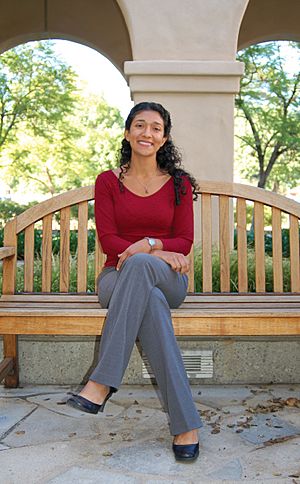Azita Emami facts for kids
Quick facts for kids
Azita Emami-Neyestanak
|
|
|---|---|

Azita Emami in 2007
|
|
| Born |
Nain, Iran
|
| Alma mater | Stanford University Sharif University of Technology |
| Scientific career | |
| Fields | Electrical Engineering |
| Institutions | California Institute of Technology Columbia University |
| Thesis | Design of CMOS receivers for parallel optical interconnects |
| Doctoral advisor | Mark Horowitz |
Azita Emami-Neyestanak is a top professor of Electrical Engineering and Medical Engineering at Caltech. She designs tiny electronic circuits that use very little power. She also leads the Electrical Engineering Department and is a key researcher at the Heritage Medical Research Institute.
Contents
Early Life and Education
Azita Emami was born in Nain, Iran. She went to an all-girls high school where she became very interested in designing electronic parts. In 1996, she earned her bachelor's degree in electronic engineering from the Sharif University of Technology. During her studies, she created a special electronic device that makes very precise signals.
She then went to Stanford University for her advanced degrees, getting her master's in 1999 and her PhD in 2004. At Stanford, she was part of a group that designed tiny, complex electronic chips. After Stanford, she worked at the Thomas J. Watson Research Center on communication technologies. From 2006 to 2007, she was an Assistant Professor at Columbia University. Her early work focused on making tiny electronic parts (called CMOS) work well even when they didn't get much information.
Amazing Research and Career
In 2007, Professor Emami joined the California Institute of Technology (Caltech). She received a special award in 2008 to study how light and electricity work together in tiny electronic systems. In 2010, she got another grant to design high-performance sensors. By 2015, she became a lead researcher at the Heritage Medical Research Institute.
Professor Emami's work is all about finding energy-efficient ways for our electronic devices to connect with the real world. Her research group, MICS (Mixed-mode Integrated Circuits and Systems), designs circuits for sending data, sensing things, and creating medical devices. She focuses on making devices that use very little power. For example, she works on tiny devices that can act like photoreceptors for people with vision loss. These devices need to use low power so they don't get too hot and harm human tissue.
Eye Implants and Sensors
Working with the Doheny Eye Institute, Professor Emami helped create retinal eye implants. These implants use super low-power, flexible circuits. They have hundreds of tiny electrodes that can stimulate cells in the eye. Designing electronics for the eye is tricky because they can't be flat. So, Professor Emami worked with an origami expert to make an implant that could fit the curved shape of a retina.
After this, she worked on sensors that can check eye pressure for patients with glaucoma. To make sure these sensors are safe inside the body, she covered them in a special material called 'Parylene-on-oil'.
Glucose Monitors
Professor Emami also teamed up with Axel Scherer to develop an implantable glucose monitor. This tiny device can send information about blood sugar levels to a wearable reader using Bluetooth. It can warn doctors if a patient's blood sugar goes too high or too low. One of her students even found a way for the glucose sensor to use even less power!
Health Monitoring Microdevices
At the Heritage Medical Research Institute, Professor Emami creates microdevices that can monitor health and even give treatment inside a patient's body. She developed a biosensor that can constantly check important information like blood sugar, pH levels, and stress hormones. It can also act as a treatment system, releasing medicine like insulin when needed.
She also worked on a device called Addressable Transmitters Operated as Magnetic Spins (ATOMS). These tiny chips use ideas from magnetic resonance imaging (MRI) to help doctors find them inside the body. ATOMS chips have special parts that let them be located using magnetic fields. Her team is testing ATOMS to see how well they work and how they can help with very precise surgery. In 2017, she was named the Andrew and Peggy Cherng Professor at Caltech, a position supported by the founders of Panda Express.
Helping Other Engineers
Professor Emami is also an editor for an important engineering journal and gives talks to other engineers. She is the Executive Officer of the Electrical Engineering Department at Caltech. Besides her research, she works to make engineering a more welcoming field for everyone.

